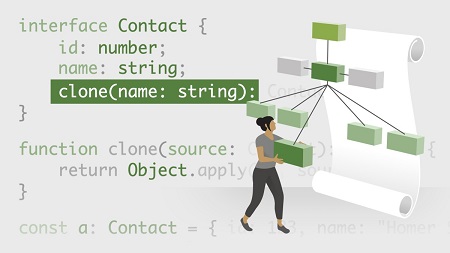English | MP4 | AVC 1280×720 | AAC 48KHz 2ch | 2h 15m | 1.14 GB
TypeScript lets you write JavaScript the same way you always do. That’s because TypeScript compiles to plain JavaScript and works with any browser, any host, and any operating system. It adds a variety of helpful tools and syntax to an already mature language, bringing the power and productivity of open-source, object-oriented development to fully compatible, core JavaScript.
In this course, Jess Chadwick teaches you how to leverage the full power of the TypeScript language in your JavaScript applications. Revisit some of the JavaScript fundamentals before turning to the data types, classes, generics, modules, and decorators that are unique to TypeScript. Get tips on defining complex types, extending and extracting metadata from existing types, and working with JavaScript modules to make your code more efficient. You can even try out your new TypeScript skills with the practice challenges along the way.
Table of Contents
Introduction
1 Learning TypeScript
2 Why TypeScript
3 Sample code and other online resources
Introducing TypeScript to Your Application
4 Installing TypeScript
5 Adding TypeScript to an existing solution
6 Adding type checking to JavaScript files
7 Importing third-party types
8 Challenge JavaScript to TypeScript
9 Solution JavaScript to TypeScript
Basic TypeScript Usage
10 Primitives and built-in types
11 Creating custom types with interfaces
12 Defining types using type aliases
13 Defining enumerable types
14 Typing functions
15 Defining a metatype using generics
16 Challenge Types
17 Solution Types
Defining More Complex Types
18 Combining multiple types with union types
19 Keyof operator
20 Typeof operator
21 Indexed access types
22 Defining dynamic but limited types with records
Extending and Extracting Metadata from Existing Types
23 Extending and modifying existing types
24 Extracting metadata from existing types
25 Challenge The right type
26 Solution The right type
Adding Dynamic Behavior with Decorators
27 What are decorators and why are they helpful
28 Creating a method decorator
29 Creating decorator factories
30 Creating a class decorator
31 Creating a property decorator
Working with Modules
32 Module basics
33 Share code with imports and exports
34 Defining global types with ambient modules
35 Declaration merging
36 Executing modular code
Resolve the captcha to access the links!
